On the Monday morning of May 30th, 1921, a young black man, a shoe shiner named Dick Rowland (known as "Diamond Dick" to his customers), was riding in an elevator in the Drexel Building at 3rd and Main in Tulsa, Oklahoma. The elevator operator was a 17 year old white girl named Sarah Page. In the elevator, amongst the commotion, Mr. Rowland touched Ms. Page. She screamed as the elevator doors opened. Dick Rowland was arrested.
The next morning, at 11:30 am, the Tulsa Tribune ran with the story. This story lead to a series of events that will later be known as the Tulsa Race Massacre. Before diving into that, let’s back up a bit. This exchange between Rowland and Page was supposedly the spark that landed on 2 different groups of people in 2 completely different ways, and lead to a mass confrontation with guns, bombs, and genocide. How did that happened?
After the Civil War
BRIEFLY - In 1865 there were two opposing forces stretched beyond the boundaries of the battleground known as the American Civil War. The Freedmen's Bureau had been established by Abraham Lincoln to aid in the transition of newly-freed slaves. At the same time, the first iteration of the Ku Klux Klan saw the light of day. With a sweeping, coordinated effort, the Federal Government was able to put an end to the KKK by 1871. On March 1, 1875, the Civil Rights Act was enacted affirming “equality of all men before the law” and prohibited racial discrimination in public places. The country was moving toward a multi-racial, inclusive democracy, and white supremacists had a meltdown.
President Andrew Johnson made a series of decisions that placed the Confederates who chose to war against the United States in new politically powerful positions. By 1872, there was enough traction to cause the government to refused to budget the Freedman’s Bureau, shutting it down permanently leaving Black Americans to fend for themselves. In 1883 the Supreme Court reversed the Civil Rights Act of 1875 and made it legal for companies to be prejudiced against Black Americans.
A Lost Cause
In 1894, Caroline Meriwether Goodlett and Anna Davenport Raines founded the United Daughters of the Confederacy and began one of the most successful propaganda campaigns in American history, rewriting Civil War history in the style of Southern historians like Edward A. Pollard and General Jubal A. Early. This propaganda campaign became known as “The Lost Cause.” If you ever heard that the Civil War was fought for states' rights and the economy, or read that slaves were well-treated and enjoyed the hard work to the point of singing songs… then you have experienced brushes of Lost Cause white-washing.
White-washing begets white-repainting and using their fundraising and lobbying skills, the United Daughters of the Confederacy were able to get Confederate monuments erected and push legislation honoring Confederate legacies all across the United States. It was an audacious and loud display that created a purposeful grey cloud over the country… a cloud that separated the African-Americans who walked the sidewalks beneath the white Confederate men who floated on stone pedestals above.
The matronly-laid foundation established by the United Daughters of the Confederacy from 1894 to the mid 1910s allowed for a more open acceptance of white supremacy sympathies, and so the Ku Klux Klan was able to resurface in 1914 with their official coming out party punctuated in 1915 with a 3-hour long movie called “Birth of a Nation,” directed by D. W. Griffith. To tell what a difference a few years of propaganda can make, Thomas Dixon Jr.'s 1905 novel and play called "The Clansman" was wildly panned as trying to reopen old wounds. D. W. Griffith's film called “The Clansman” from 1911 was also quite a failure. But after a few years of Confederate flattery and fawning... "Birth of a Nation" had a continuous, successful run from 1915-1919 and was the highest grossing film until it was overtaken by "Gone with the Wind" in 1939.
The coordinated efforts of an underground organization's intent on reversing the progress of African-Americans now had a conduit to the masses - open-sourced public access to violent racial discrimination. "Birth of a Nation" used an old racist troupe that gave permission for violent behavior: 'Black people are inherently wild and prone to violence, and therefore in need of white control and structure.'
There was one major problem, however.
Black Wall Street
Tulsa, Oklahoma’s Greenwood District was thriving. Post-Freedmen's Bureau the area did much better at elevating freed slaves and their children on their own. Black residents were wealthy. Businesses were flourishing. Financial freedom was contagious to every American - white and black - who worked with and around the Greenwood District. The financial security lead to the Greenwood District getting the nickname "the Black Wall Street." As racial tensions were purposefully stoked by the KKK and their sympathizers, the residents of Black Wall Street went about their day, working hard and enjoying life with prosperity, oblivious of what was brewing right outside their city and in neighboring towns. In order for "Birth of a Nation" canon to be accurate, Greenwood district MUST be eradicated.
Buck Colbert Franklin
Buck Colbert Franklin was born on May 6, 1879, near Homer in Pickens County, Chickasaw Nation, Indian Territory (now part of Oklahoma). He was an attorney who lived and worked in the Greenwood District and one of the residents whose story reflect a layered cross summation of eyewitness, victim, and survivor. It took him a few years, but he was able to write and incredible account, and I've decided to add a large part of it below.
Franklin begins his story with his meeting a Black veteran and his wife identified as Mr. and Mrs. Ross - a bookend-style story that I've largely excluded for space but the inclusion of Mr. Ross in Franklin's manuscript, his service to this country in World War 1, his wife, and his mother are tremendously important to the greater narrative. I encourage everyone to read the full account to see exactly how Mr. Ross' story interwinds with the mental, emotional, and physical trauma experienced by the thousands of Black Americans who lived through this genocide.
In Buck Franklin's Words
I'll pick up Buck Franklin's story here:
It is now May 31st, 1921. The day is just beginning. Sweet-throated birds warble their songs of joy in the tree-tops, fanned by the refreshing zephyr, and the dew sparkles upon the grass like countless little diamonds, as old Sol rises above the eastern horizon and shinning in all his resplendent glory, thrusts his myriad rays upon the busy world below. An unbroken stream of pedestrians--male and female--passes down Greenwood Avenue. It is made up of laborers, some empty-handed and others with dinner pails, on their way to work. They hurry along as if they are late. A few of the more pretentious ones pass in their own cars, or in jitneys, or upon busses. Then comes a lull--a lull before the storm.
It is now II:30, A.M.of the same day and the first edition of the Tulsa Daily Tribune is out. The newsies are hawking their wares. Listen: "Tulsa Daily Tribune,Mister? Tribune, Mister? All about a Negro assaulting a white girl--read about it--Tribune, Mister?"
And so thousands of people buy the Tribune and scan its pages for the article about the alleged assault. They find it tucked away in a small space on one of the inside pages of the paper. In the twinkling of an eye, a part of Tulsa is changed from the happy, joyous, care-free to looks of grim determination.
[** If one were to look for this particular article as I did, they would come up empty. The article has been ripped from the official Tulsa Tribune archive and saved to the microfiche archive decades ago, as seen below. The attached article was found elsewhere. **]
I had an unusally hard day of it at court and in my office. By noon, I had finished the trial of a land case that was begun two days before. I had spent the entire afternoon briefing a law suit docketed for trial the following weeks. And so, I retired rather early. But the shooting continued. I arose, dressed and went to the phone to call the sheriff's office to find out the trouble. I could not make connection. The next thought was my office and to it I hastened. Upon reaching Greenwood Avenue, the same street upon which my office was then, and is now, located, found the street congested with humanity and vehicles of all kinds and descriptions. Everybody, except the business men, was running about excitedly. The business men remained in their places of business, looking distressed and deeply concerned. Pushing and elbowing my way through the crowd, I finally reached my office. Again I tried to call the sheriff's office and again I failed to get connection. I was puzzled. I of course knew that there was trouble--that a race riot--or race war, as it afterward proved to be--was in the making and that we would soon be in the midst of a great catastrophe if something was not done at once to avert it.
I started to town; but did not get very far before I concluded that such a move was both foolish and suicidal. I could do neither myself, nor anybody else any good by attempting such a course. So, after remaining on the streets for an hour or more, I returned to my room. I slipped out of my top shirt and lay down and tried to think--sleeping was out of the question. I soliloquized, "Here I am, peaceable and law-abiding citizen, I have harmed no one--just like thousands of others of my race here--and yet I cannot now walk the street, upon a peaceful mission, in safety." This seemed hard to me. You see, I had never been in a mob before. Up to then, I knew absolutely nothing about mob-psychology. Since becoming a man, I have always been kept busy and never had had an occasion to study the mob-spirit. I had thought, foolishly, I suppose, that a peaceable, law abiding citizen could go wherever he he had business--upon the streets. I was rudely disillusioned
About mid-night, I arose and went to the north porch on the second floor of my hotel and, looking in a north-westernly direction, I saw the top of stand-pipe hill literally lighted up by the blazes that came from the throats of machine guns, and I could hear bullets whizzing and cutting the air. There was shooting now in every direction, and the sounds that came from the thousands and thousands of guns were deafening. When the eastern sky reddened, announcing the approach of day, I was still standing on the upper porch thinking--thinking--thinking. And how different was the coming of this day from that of the day before. Now, one could see no stream of laborers passing down Greenwood Avenue, happy and care-free as on the morn before; no birds warbled their sweet songs, or, if they did, their voices were hushed in the din of battle. The grass was wet again with the morning dew and the sun rose again to travel the path known to his feet since time began, but neither had any charm on the morning for the sons of Ham in Tulsa.
I went from the front porch into the bath room and washed my face, and thereafter went into my room and dressed. I left the building for my office. As I reached the side-walk a shrill whistle sounded from the direction of stand-pipe hill. And then, immediately thereafter, five thousand feet, it seemed, were heard descending that hill in my direction. On they rushed, whooping to the top of their voices like so many cow-boys, and firing their guns every step they took. I quickened my pace and, cutting across vacant lots and dodging behind buildings, I finally reached Frankfort Place, about the middle of the three hundred block.
I reached my office in safety; but I knew that that safety would be shortlived. I now knew the mob-spirit. I knew too that government and law and order has broken down. I knew that mob law had been substituted in all its fiendishness and barbarity. I knew that the mobbist cared nothing about the written law and the constitution and I also now knew that he had neither the patience nor the intelligence to distinguish between the good and the bad, the law abiding and the lawless in my race. From my office window, I could see planes circling in mid-air. They grew in number and hummed, darted and dipped low. I could hear something like hail falling upon the top of my office building. Down East Archer, I saw the old Mid-Way hotel on fire, burning from its top, and then another and another and another building began to burn from the top. "What, an attack in the air too?", I asked myself. Lurid flames roared and belched and licked their forked tongues in the air. Smoke ascended from the sky in thick, black volumes and amid it all, the planes--now a dozen or more in number--still hummed and darted here and there with the agility of natural birds of the air. Then a filling station farther down Easy Archer caught on fire from the top.I feared now an explosion and decided to try and move to safer quarters. I came out of my office, locked the door and descended to the foot of the steps.The side-walks were literally covered with burning turpentine balls. I knew all too well where they came from and I knew all too well why every burning building first caught from the top. I paused and waited for an opportune time to escape.
[** At the time, very few papers reported about airplanes. It was something that NONE of the Ku Klux Klan wanted ANYONE to know about because airplanes were still a bit of a rarity. Any acknowledgment for bombs being dropped by planes would lead to the obvious investigative step of finding out who had planes within a certain radius, and whether that radius included the KKK stronghold in East Texas. Efforts to remove that element from the narrative was necessary and the idea that airplanes were used was dismissed as "Black hysteria" and "overactive imaginations..." excuses that worked for decades. The reality is that one could buy kits to build planes (the ad below is from 1919), and the U.S. Army sold off JN-4 Jenny biplane as surplus after The Great War. **]
I saw two sights that will live in my memory to my dying days. One was a woman on the opposite side of the street. She was travelling south,-hair disentangled and disheveled--in the very path of whizzing bullets. She was calling wildly to a little tot that, a few moments before, had dashed in panic before her and turned off Greenwood on Archer at the corner. I hollered to her, "Turn back woman, for God's sake turn back. You will be mown down". Never turning her head, she answered, as she hurried on, "I must follow my child". And so she did follow her child and not a bullet touched her though they literally rained down the street. This brave self-denying mother lives today here in Tulsa and with her that tot--now a splendid young lady--whom she risked her life to save.
The other sight was occasioned by the Piro building catching on fire from the top. (This was a frame building then). The fire dislodged those in the building--a woman, two children and three men.They emerged in wild confusion and came on in my direction. The little children--they were both girls--out ran the others and passed the place where I was standing with the speed of the wind. The woman ran across the street and into the foot of the steps of my office building--right where I was standing--and fell upon her knees and commenced to pray, totally oblivious of my presence.I don't think she ever saw me. And such a prayer--She asked God to save her and her children from whom she had just been separated. This prayer was uttered over and over. I am unable to say whether that prayer was answered or not. I have lived in Tulsa continuously ever since that memorable morning, but I have never seen that woman since. I know I would know her if I were to meet her, even today.
The three men--one of whom carried a heavy trunk on his shoulder--were all killed as they were crossing the street--killed before my very eyes. The man who carried the trunk was very old. Likely, he had in that trunk many things of great value (Negroes in Tules then were as a rule, very wealthy) and thought as much of the contents thereof as he did of his own life. When the old man was hit--no doubt by a dozen bullets--he dropped his burden and shreiked and fell sprawling upon the hard paved street. Blood gushed from every wound and ran down the street. I turned my head from the scene.
From every direction, except the North, we were surrounded, and the mob was closing in upon me. Across the street, directly in front of me, stood the Gurley Building, property of a very wealthy and--up to that time- a very enfluential colored man. I heard shots fired from behind that building and heard angry and profane voices, saying "Come out of there, Gurley-- you black s--o--a--b." I saw an opening to move on and so I sped North, out Greenwood Avenue. About one hundred yards on the way out, I was joined by I.H. Spears, another colored attorney and we proceeded on together. I thought that may be I could make it back to my hotel and find a gun of some sort there-- in some of those rooms. At the intersection of North Greenwood and East Easton--the point at which I intended to turn west--I looked across to my left and there, in stone's cast, stood the Ross residence--burning from the top. On the front porch stood Mother Ross, with outstretched and trembling hands, begging a mob that was approaching from the northwest to spare her home and family (Evidently she had not then discovered her house on fire). From within I could hear the report of some high-powered rifles.
I looked North and directly in front of us stood a thousand boys, it seemed, with guns pointed at our heads. They commanded us to "right about face". Then one half starved ruffian came forward to search us. Finding no weapon, he started to take my money. At this I balked. This was the last straw. I had endured about all I could and decided then and there to die, if necessary be-fore I would be robbed by that bunch of hungry out-laws. I have always thanked my God that none of the other members of my family were in the city. My wife and three children were down on the farm--one hundred miles away--and my oldest child--a daughter-- was in College in Tennessee.
The ruffians marches us back down Greenwood to First Street, thence on First Street to Main Street, thence on Main Street to Brady Street and hence on Brady Street to convention hall. You see, this was one of the many places of detention, refuge or whatever you wish to call it, to which my Race was taken when dislodged from its home. Here, those who cared to accept the fare, the people were fed and watered like so many cattle by the benefactors who had allowed the mob to take their government away from them and trample their laws and constitution under their unhallowed and barbarous feet.
I lived the whole experiences of the Race; the experiences of royal ancestry beyond the sea; experiences of the slave ships on their first voyage to America with their human cargo; experiences of American slavery and its concomitant evils; experiences of loyalty and devotion of the Race to this nation and its flag in war and in peace;… I thought of the place the preachers call hell and wondered seriously if there was such a mystical place--It appeared, in this surrounding--that the only hello was the hell on this earth, such as the Race was then passing through.
For fully forty eight hours, the fires raged and burned everything in its path and it left nothing but ashes and burned safes and trunks and the like where once stood beautiful homes and business houses. And so proud, rick, black Tulsa was destroyed by fire--that is its buildings and property; but its spirit was neither killed nor daunted. It is however not within the purpose of this true story to dwell on this; nor is it our purpose to discuss here the cause or causes of this great shame, except to say that the chief cause was economic. The Negroes were wealthy and there were too many poor whites who envied them. Within two hours after the alleged assault had been reported, there were not a dozen white men here who did not know that this alleged assault consisted of a poor laboring, Negro by accidentally stepping on the foot of a very poor but worthy white girl while the two were on a very crowded elevator in one of the down town business buildings: nor yet is it our purpose here to discuss the wonderful, almost miraculous come-back of the Race here in the accumulation of property and in the acquiring of a larger, richer and fuller spirtual life.
There were about 6,000+ Black residents of Tulsa who were rounded up and kept in confinement in 1 of 3 facilities: Convention Hall, Tulsa County Fairgrounds, and McNulty Park baseball stadium. The residents were kept at these facilities until the white attackers could shuffle through the wreckage retrieving safes, trunks, and other valuables.
After the attack and genocidal massacre, the KKK found renewed acceptance in Oklahoma. A good portion of the pictures we have from the time came from post cards because white supremacists couldn't stop bragging about successfully leveling 10 blocks of a thriving Black society. All the pictures that have writing etched into them were all post cards.
After the Attack
From the time of June 1, 1921 until the time Buck Franklin wrote down the events, there were many efforts to remove all trace of the events. The newspapers were brutal in their assessment of the situation. This editor's note comes from "The Tulsa Tribune" (Tulsa, OK) June 4, 1921 (page 8) just 3 days after the massacre and the same day martial law had been suspended. That second paragraph hasn't changed in the 100 years since.
There was a lot of attention given to the cause - what started it, what was the fuse, what was the ONE thing that caused the massacre. Buck Franklin didn't want to get into it because it was a long process. By the time he wrote of his survival, the story had became so twisted, there was doubt that that there was even a young man named "Dick Rowland" or a young woman named "Sarah Page." It was so appalling that a Black community could do a better job at insuring financial security and equality than their white counterparts all over the south, that it had to be eliminated with as much firepower as possible. No one pointed at the white racists who had a choice to emulate the civic model in their own communities OR follow their "Birth of a Nation" fantasies and tear the Greenwood District down as dramatically as possible.
The newspapers made it clear where they stood.
Further Reading
The Smithsonian has an excellent timeline of events, the aftermath, the mental and emotional road to recovery HERE.
Mount Zion Baptist Church was burned to the ground - the ruins of it used as marker for so many pictures. You can find a fascinating story about the church at Historic Tulsa HERE.
You can read Buck Franklin's full account in his original typing by going HERE. The end of the story has Ross in a state where the word "survivor" does not seem appropriate. It is just ONE example of the trauma experienced by thousands of African-Americans wading through rubble.
The Tulsa Historical Society was absolutely essential in compiling - and digesting - this horror. If you don't practice this already, take a moment and spend some time getting to know your local historical society.
This land - and the cost of its contents - has never been resolved with the rightful owners in the 100 years since the "great shame" known as the Tulsa Massacre.
POST SCRIPT FACT 1:
Cross burning was not part of the Klan’s modus operandi until after the 2 cross-burning sequences in the movie “Birth of a Nation.” The imagery of crosses on fire could be found in the book, but it wasn't thought of literally until Griffith added the fire for more dramatic effect. 10 months after the movie opened to the public, the first cross-burning occurred in the United States.
POST SCRIPT FACT 2:
June 1, 1921 was the first time citizens on American soil had been bombed by aerial assault. The next aerial attack on our country would come 20 years later with the bombing of Pearl Harbor on December 7, 1941.



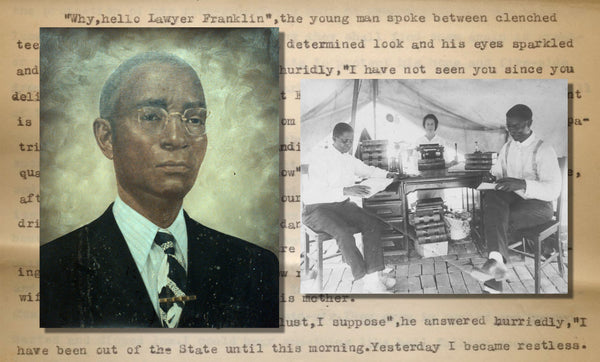











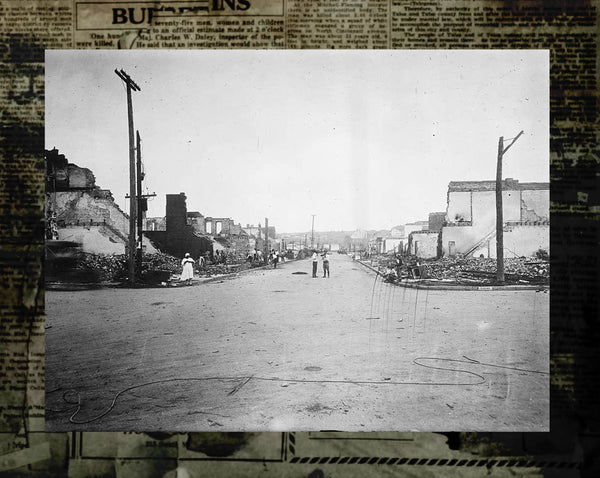


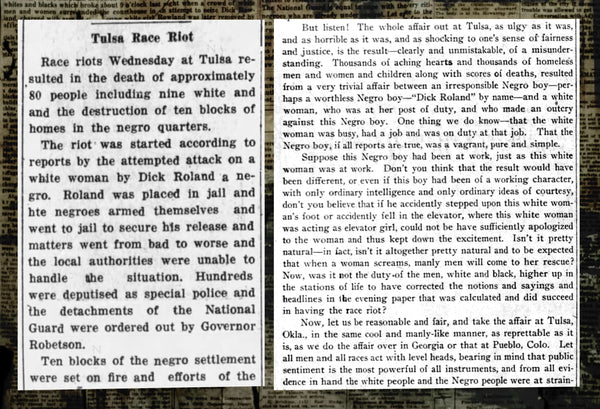

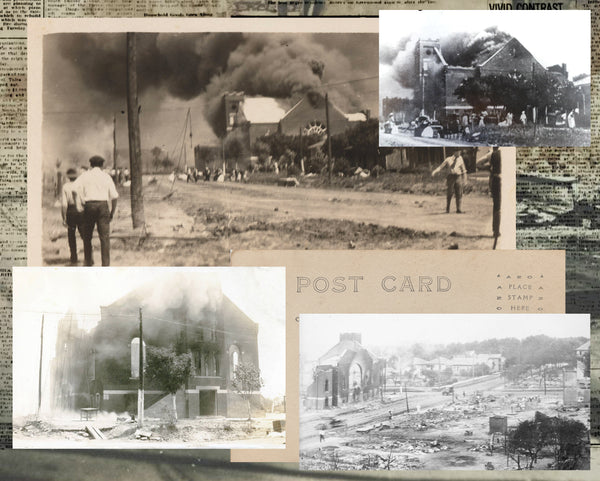

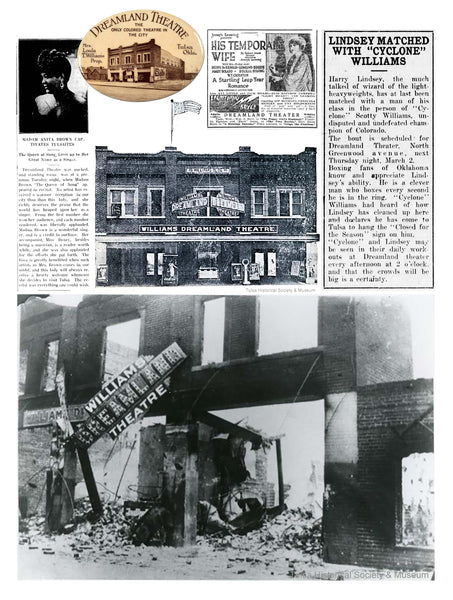




Leave a comment